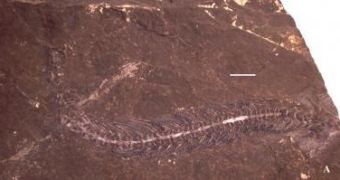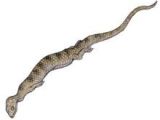A team from the University of Alberta has discovered the oldest limbless lizard ever.
The snakelike marine lizard is 95 million-year-old, thus lived during the Cretaceous (the last dinosaur age). "It adds to the picture we have of what was happening 100 million years ago. We now know that losing limbs isn't a new thing and that lizards were doing it much earlier than we originally thought. On top of that, this lizard is aquatic. All the examples we have in our modern world are terrestrial, so it's a big deal," said Dr. Michael Caldwell, from the Faculty of Science.
The new species, named Adriosaurus microbrachis, comes with clues of the evolution of terrestrial lizards returning to water. The fossil was discovered during the 19th Century in a limestone quarry in Slovenia but remained at the Natural History Museum in Trieste, Italy for almost a century till it triggered Caldwell's interest during a 1996 trip to Europe.
Soon, it appeared that the lizard's front limbs were not fully grown during development. "There are lots of living lizards that love to lose their forelimbs and then their rearlimbs, but we didn't know it was being done 100 million years ago and we didn't know that it was happening among groups of marine lizards," said Caldwell. "This discovery is an excellent example of paleontological data being used to elucidate the potential molecular genetic causes of a major evolutionary transition," said Dr. Martin Cohn, from the Department of Zoology and University of Florida Genetics Institute.
"This is a terrifically important discovery because it shows, in a group of animals thought to be closely related to snakes, that forelimb reduction and trunk elongation were well underway before the onset of hindlimb reduction," said Cohn. "By uncovering the sequence of the morphological changes that occurred during evolution of a snake-like body plan, the study provides important clues as to which developmental mechanisms could have been involved."
The snake-like lizard was about 10 -12 inches (25-30 cm) long, presented a small head, an elongated neck, body and tail and relatively large and well-developed rear limbs. The bones of the forearm, including the hands and digits, did not develop.
"For some oddball reason the forelimbs were lost before the rear limbs when you would think it would be the opposite. The front limbs would be useful for holding onto dinner or digging a hole but it must be developmentally easier to get rid of the forelimbs,"said Caldwell. The oldest ancient fossil snakes also missed their front limbs but kept their hind limbs.
Living legless lizards display any possible variation in limb reduction from a perfectly formed back limb with no forelimb, or a spike for a forelimb and one or two toes on the rear limbs, to total limblessness, and belong to various groups, from skinks to tegu lizards and glass lizards. "This discovery is one more data point that might help us answer some questions and perhaps shed some light on the fin to limb transition, which is a key step in the evolution of land animals," said Caldwell. "It doesn't give us all the answers but it's a start."

 14 DAY TRIAL //
14 DAY TRIAL // 
